Lexus GS300 2002, GS350 2002, GS400 2002, GS430 2002, GS450H 2002 Owner Manual
...
SECTION 6 ± 2
SERVICE PROCEDURES AND
SPECIFICATIONS
Engine
Specifications (GS430) . . . . . . . . . . . . . . . . . . . . . . . . . . . . . . . . . . . 244 Specifications (GS300) . . . . . . . . . . . . . . . . . . . . . . . . . . . . . . . . . . . 246 Fuel . . . . . . . . . . . . . . . . . . . . . . . . . . . . . . . . . . . . . . . . . . . . . . . . . . . . 248 Fuel pump shut off system . . . . . . . . . . . . . . . . . . . . . . . . . . . . . . . . 250 Facts about engine oil consumption . . . . . . . . . . . . . . . . . . . . . . . . 251 Used engine oil . . . . . . . . . . . . . . . . . . . . . . . . . . . . . . . . . . . . . . . . . . 252 Checking the engine oil level . . . . . . . . . . . . . . . . . . . . . . . . . . . . . . 253 Checking the engine coolant level . . . . . . . . . . . . . . . . . . . . . . . . . . 255 Spark plugs . . . . . . . . . . . . . . . . . . . . . . . . . . . . . . . . . . . . . . . . . . . . . 257
243
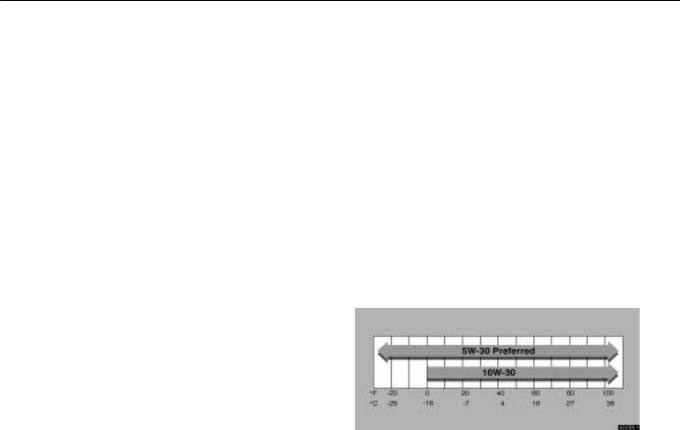
ENGINE
SPECIFICATIONS (GS430)
± GENERAL
Model |
3UZ±FE |
||
Type |
8 cylinder V type, 4 cycle, gasoline |
||
Bore and stroke |
91.0 X 82.5 mm (3.58 X 3.25 in.) |
||
Displacement |
4293 cm3 (261.9 cu.in.) |
||
Valve clearance (engine cold) |
|
|
|
Intake |
0.15 ± 0.25 mm (0.006 ± 0.010 in.) |
||
Exhaust |
0.25 ± 0.35 mm (0.010 ± 0.014 in.) |
||
Drive belt tension |
Automatic adjustment |
||
|
|
|
|
± LUBRICATION SYSTEM |
|
|
|
|
|
|
|
Oil capacity |
|
|
|
Drain and refill |
|
|
|
with filter |
5.2 L (5.5 qt., 4.6 lmp.qt.) |
||
without filter |
4.9 L (5.2 qt., 4.3 lmp.qt.) |
||
Oil grade |
API SJ, ºEnergy±Conservingº multigrade engine oil or |
||
|
ILSAC multigrade engine oil |
||
Recommended oil viscosity (SAE): |
|
|
|
|
|
|
|
|
|
|
|
|
Temperature range anticipated before next oil change |
||
|
|
|
|
244

ENGINE
± COOLING SYSTEM
Capacity |
|
|
9.0 L (9.5 qt., 7.9 lmp.qt.) |
|
Coolant type |
|
ºToyota Long Life Coolantº or equivalent |
||
|
|
|
With ethylene±glycol type coolant for a proper corrosion |
|
|
|
|
protection of aluminum components |
|
|
|
|
Do not use alcohol type antifreeze or plain water alone. |
|
|
|
|
|
|
± FUEL |
|
|
|
|
|
|
|
|
|
Fuel type |
|
|
Only UNLEADED |
|
Octane rating |
|
91 (Research octane number 96) or higher |
||
|
|
|
|
|
± IGNITION SYSTEM |
|
|
|
|
|
|
|
|
|
Spark plug |
± Make |
DENSO |
SK20R11 |
|
|
± Gap |
NGK |
IFR6A11 |
|
|
|
1.1 mm (0.043 in.) |
||
|
|
|
|
|
± ELECTRICAL SYSTEM |
|
|
|
|
|
|
|
|
|
Battery |
Open voltage at 20 C (68 F): |
12.7V |
Fully charged |
|
|
|
|
12.3V |
Half charged |
|
|
|
11.9V |
Discharged |
|
|
|
[Voltage that is checked 20 minutes after the key is removed |
|
|
|
|
with all the lights turned off] |
|
|
Charging rates |
|
5A max. |
|
|
|
|
|
|
245
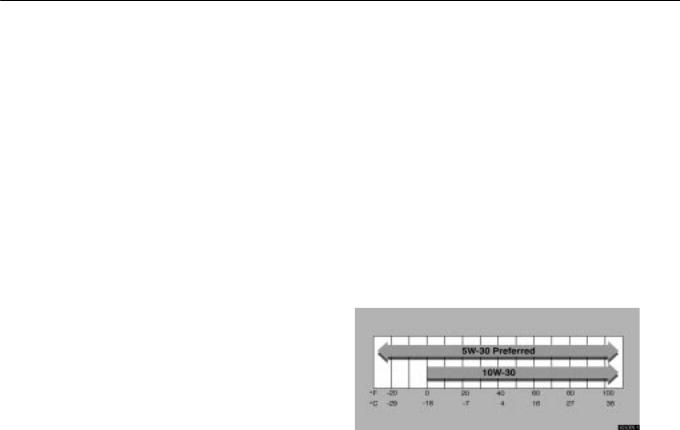
ENGINE
SPECIFICATIONS (GS300)
± GENERAL
Model |
2JZ±GE |
||
Type |
6 cylinder in line, 4 cycle, gasoline |
||
Bore and stroke |
86.0 X 86.0 mm (3.39 X 3.39 in.) |
||
Displacement |
2997 cm3 (182.9 cu.in.) |
||
Valve clearance (engine cold) |
|
|
|
Intake |
0.15 ± 0.25 mm (0.006 ± 0.010 in.) |
||
Exhaust |
0.25 ± 0.35 mm (0.010 ± 0.014 in.) |
||
Drive belt tension |
Automatic adjustment |
||
|
|
|
|
± LUBRICATION SYSTEM |
|
|
|
|
|
|
|
Oil capacity |
|
|
|
Drain and refill |
|
|
|
with filter |
5.4 L (5.7 qt., 4.8 lmp.qt.) |
||
without filter |
5.1 L (5.4 qt., 4.5 lmp.qt.) |
||
Oil grade |
API SJ, ºEnergy±Conservingº multigrade engine oil or |
||
|
ILSAC multigrade engine oil |
||
Recommended oil viscosity (SAE): |
|
|
|
|
|
|
|
|
|
|
|
|
Temperature range anticipated before next oil change |
||
|
|
|
|
246

ENGINE
± COOLING SYSTEM
Capacity |
|
|
7.7 L (8.1 qt., 6.8 lmp.qt.) |
|
Coolant type |
|
ºToyota Long Life Coolantº or equivalent |
||
|
|
|
With ethylene±glycol type coolant for a proper corrosion |
|
|
|
|
protection of aluminum components |
|
|
|
|
Do not use alcohol type antifreeze or plain water alone. |
|
|
|
|
|
|
± FUEL |
|
|
|
|
|
|
|
|
|
Fuel type |
|
|
Only UNLEADED |
|
Octane rating |
|
91 (Research octane number 96) or higher |
||
|
|
|
|
|
± IGNITION SYSTEM |
|
|
|
|
|
|
|
|
|
Spark plug |
± Make |
DENSO |
SK16R±P11 |
|
|
± Gap |
|
1.1 mm (0.043 in.) |
|
|
|
|
|
|
± ELECTRICAL SYSTEM |
|
|
|
|
|
|
|
|
|
Battery ± |
Open voltage at 20 C (68 F): |
12.7V |
Fully charged |
|
|
|
|
12.3V |
Half charged |
|
|
|
11.9V |
Discharged |
|
|
|
[Voltage that is checked 20 minutes after the key is removed |
|
|
|
|
with all the lights turned off] |
|
|
Charging rates |
|
5A max. |
|
|
|
|
|
|
247

ENGINE
FUEL
Fuel type
Your vehicle must use only unleaded gasoline.
To help prevent gas station mixups, your Lexus has a smaller fuel tank opening. The special nozzle on pumps with unleaded fuel will fit it, but the larger standard nozzle on pumps with leaded gas will not.
At a minimum, the gasoline you use should meet the specifications of ASTM D4814 in the U.S.A. and CGSB 3.5±M93 in Canada.
NOTICE
Do not use leaded gasoline. Use of leaded gasoline will cause the three±way catalytic converter to lose its effectiveness and the emission control system to function improperly. Also, this can increase maintenance costs.
Octane rating
Select premium unleaded gasoline with an Octane Rating of 91 (Research Octane Number 96) or higher for optimum engine performance. However, if such premium type cannot be obtained, you may temporarily use unleaded gasoline with an Octane Rating as low as 87 (Research Octane Number 91).
Use of unleaded fuel with an octane number or rating lower than stated above will cause persistent heavy knocking. If severe, this will lead to engine damage.
If your engine knocks ...
If you detect heavy knocking even when using the recommended fuel, or if you hear steady knocking while holding a steady speed on level roads, consult your Lexus dealer.
However, now and then, you may notice light knocking for a short time while accelerating or driving up hills. This is no cause for concern.
Gasoline containing detergent additives
Lexus recommends the use of gasoline that contains detergent additives to avoid build±up of engine deposits.
However, all gasoline sold in the U.S. contains detergent additives to keep clean and/or clean intake systems.
Quality gasoline
Automotive manufacturers in the U.S., Europe and Japan have developed a specification for quality fuel named World±Wide Fuel Charter (WWFC) that is expected to be applied world wide. The WWFC consists of three categories that depend on required emission levels. In the U.S., category 3 has been adopted. The WWFC improves air quality by providing for better emissions in vehicle fleets, and customer satisfaction through better vehicle performance.
248

ENGINE
Cleaner burning gasoline
Cleaner burning gasoline, including reformulated gasoline that contains oxygenates such as ethanol or MTBE is available in many areas.
Lexus recommends the use of cleaner burning gasoline and appropriately blended reformulated gasoline. These types of gasoline provide excellent vehicle performance, reduce vehicle emissions, and improve air quality.
Oxygenates in gasoline
Lexus allows the use of oxygenate blended gasoline where the oxygenate content is up to 10% ethanol or 15% MTBE. If you use gasohol in your Lexus, be sure that it has an octane rating no lower than 87.
Lexus does not recommend the use of gasoline containing methanol.
Sulfur in gasoline
If your vehicle is certified to California Emission Regulation, the vehicle is designed to operate on California cleaner burning gasoline (CBG) that contains lower sulfur. If you cannot use California CBG, your emission control system may suffer damage and turn on the Malfunction Indicator Lamp.
If the malfunction is caused by the type of fuel used, repairs may not be covered by your warranty.
Gasoline containing MMT
Some gasoline contain an octane enhancing additive called MMT (Methylcyclopentadienyl Manganese Tricarbonyl).
Lexus does not recommend the use of gasoline that contains MMT. If fuel containing MMT is used, your emission control system may be adversely affected. The Malfunction Indicator Lamp on the instrument cluster may come on. If this happens, contact your Lexus dealer for service.
Gasoline quality
In a very few cases, you may experience driveability problems caused by the particular gasoline that you are using. If you continue to have unacceptable driveability, try changing gasoline brands. If this does not rectify your problem, then consult your Lexus dealer.
249
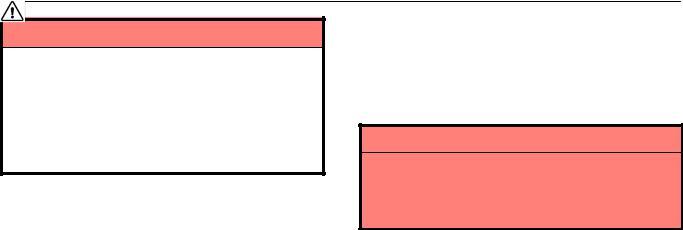
ENGINE
NOTICE
Do not use gasohol other than stated above. It will cause fuel system damage or vehicle performance problems.
If drivability problems are encountered (poor hot starting, vaporizing, engine knock, etc.), discontinue its use.
Take care not to spill gasohol during refueling. Gasohol may cause paint damage.
Fuel tank capacity
75 L (19.8 gal., 16.5 lmp.gal.)
FUEL PUMP SHUT OFF SYSTEM
The fuel pump shut off system stops supplying fuel to the engine to minimize the risk of fuel leakage when the engine stalls or an airbag inflates upon collision. To restart the engine after the fuel pump shut off system activates, turn the ignition switch to ªACCº or ªLOCKº once and start it.
CAUTION
Inspect the ground under the vehicle before restarting the engine. If you find that liquid has leaked onto the ground, it is the fuel system that has been damaged and it is in need of repair. In this case, do not restart the engine.
250

ENGINE
FACTS ABOUT ENGINE OIL
CONSUMPTION
Functions of engine oil
Engine oil has the primary function of lubricating and cooling the inside of the engine, and plays a major role in maintaining the engine in proper working order.
Engine oil consumption
It is normal that an engine should consume some engine oil during normal engine operation. The causes of oil consumption in a normal engine are as follows.
Oil is used to lubricate pistons, piston rings and cylinders. A thin film of oil is left on the cylinder wall when a piston moves downwards in the cylinder. High negative pressure generated when the vehicle is decelerating sucks some of this oil into the combustion chamber. This oil as well as some part of the oil film left on the cylinder wall is burned by the high temperature combustion gases during the combustion process.
Oil is also used to lubricate the stems of the intake valves. Some of this oil is sucked into the combustion chamber together with the intake air and is burned along with the fuel. High temperature exhaust gases also burn the oil used to lubricate the exhaust valve stems.
The amount of engine oil consumed depends on the viscosity of the oil, the quality of the oil and the way the vehicle is driven.
More oil is consumed under driving conditions such as high speeds and frequent acceleration and deceleration.
A new engine consumes more oil, since its pistons, piston rings and cylinder walls have not become conditioned.
When judging the amount of oil consumption, keep in mind that the oil may have become diluted, making it difficult to judge the true level accurately.
For example, if a vehicle is used for repeated short trips and consumes a normal amount of oil, the dipstick may not show any drop in the oil level at all, even after 1000 km (600 miles) or more. This is because the oil is gradually becoming diluted with fuel or moisture, making it appear that the oil level has not changed.
The diluting ingredients evaporate out when the vehicle is then driven at high speeds, as on an expressway, making it appear that oil is excessively consumed after driving at high speeds.
251
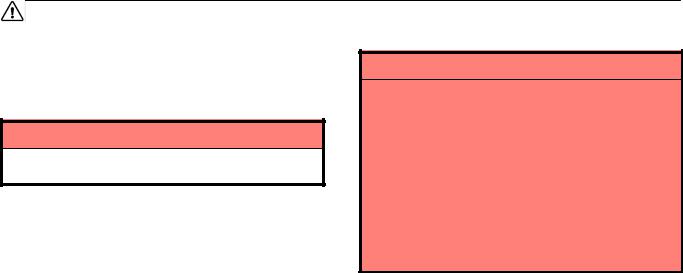
ENGINE
Importance of engine oil level check
One of the most important points in proper vehicle maintenance is to keep the engine oil at the optimum level so that oil function will not be impaired. Therefore, it is essential that the oil level be checked regularly. Lexus recommends that the oil level be checked every time you refuel the vehicle.
NOTICE
Failure to check the oil level regularly could lead to serious engine trouble due to insufficient oil.
For detailed information on oil level check, see ºChecking the engine oil levelº on page 253.
USED ENGINE OIL
CAUTION
Used engine oil contains potentially harmful contaminants which may cause skin disorders such as inflammation or skin cancer, so care should be taken to avoid prolonged and repeated contact with it. To remove used engine oil from your skin, wash thoroughly with soap and water.
Do not leave used oil within the reach of children.
Dispose of used oil and used oil filters only in a safe and acceptable manner. Do not dispose of used oil and used oil filters in household trash, in sewers or onto the ground. Call your Lexus dealer or a service station for information concerning recycling or disposal.
252
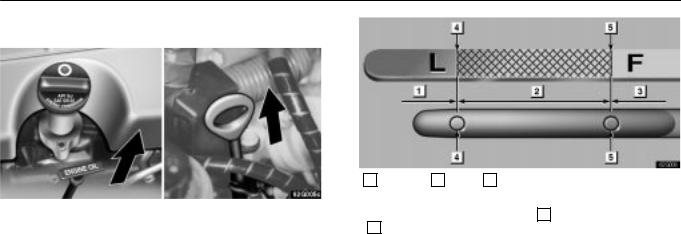
ENGINE
CHECKING THE ENGINE OIL LEVEL
GS430 |
GS300 |
With the engine at operating temperature and turned off, check the oil level on the dipstick.
1.To get a true reading, the vehicle should be on a level spot. After turning off the engine, wait a few minutes for the oil to drain back into the bottom of the engine.
2.Pull out the dipstick, and wipe it clean with a rag.
3.Reinsert the dipstick and push it in as far as it will go, or the reading will not be correct.
1 Add oil 2 O.K. 3 Too full
4. Pull the dipstick out and look at the oil level on the end. If it is between the low level mark ( 4 ) and the full level mark ( 5 ), it is O.K.
253
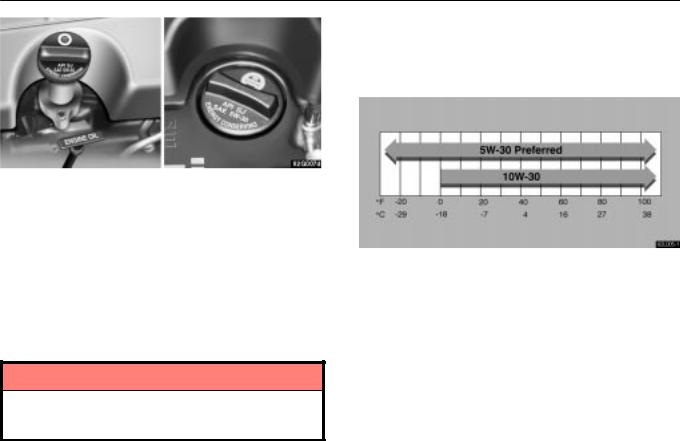
ENGINE
GS430 |
GS300 |
If the oil level is below or only slightly above the low level mark, add engine oil of the same type as already in the engine.
Remove the oil filler cap and add engine oil a little at a time, checking the dipstick. The approximate quantity of oil needed to fill between the low level mark and the full level mark on the dipstick is indicated below for reference.
When the level reaches within the correct range, return the filler cap and turn the cap clockwise until you hear a click.
Oil quantity. L (qt., lmp. qt.) |
1.8 (1.9, 1.6) |
NOTICE
Avoid overfilling, or the engine could be damaged. Check the oil level on the dipstick once again after adding the oil.
Engine oil selection
Use API SJ, ºEnergy±Conservingº multigrade engine oil or ILSAC multigrade engine oil.
Recommended viscosity (SAE):
Temperature range anticipated before next oil change
SAE 5W±30 is the best choice for your vehicle, for good fuel economy, and good starting in cold weather.
If you use SAE 10W±30 engine oil in extremely low temperatures, the engine may become difficult to start, so SAE 5W±30 engine oil is recommended.
254
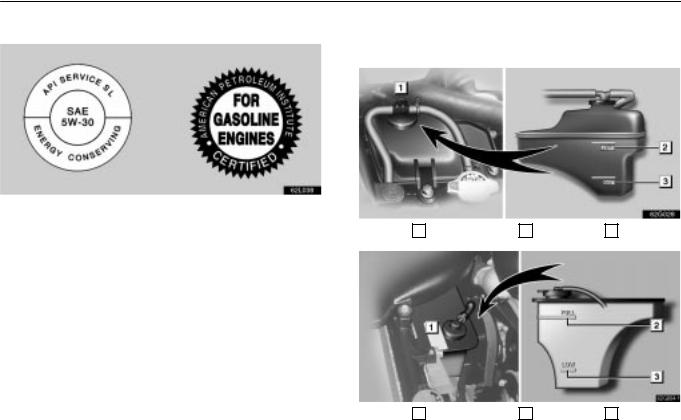
ENGINE
Oil identification marks
CHECKING THE ENGINE COOLANT
LEVEL
API Service Symbol |
ILSAC Certification Mark |
Either or both API registered marks are added to some oil containers to help you select the oil you should use.
The API Service Symbol is located anywhere on the outside of the container.
The top portion of the label shows the oil quality by API (American Petroleum Institute) designation such as SJ. The center portion of the label shows the SAE viscosity grade such as SAE 5W±30. ºEnergy±Conservingº, shown in the lower portion, indicates that the oil has fuel±saving capabilities.
The ILSAC (International Lubricant Standardization and Approval Committee) Certification Mark is displayed on the front of the container.
GS430 1 Reservoir cap 2 Upper line 3 Lower line
GS300 1 Reservoir cap 2 Upper line 3 Lower line
255
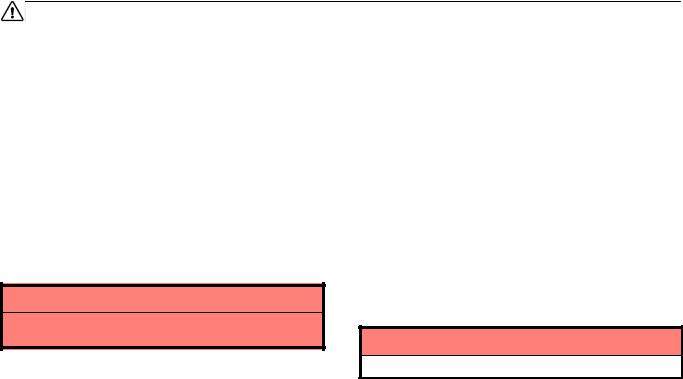
ENGINE
Look at the see±through coolant reservoir when the engine is cold. The coolant level is satisfactory if it is between theºFULLº and ºLOWº lines on the reservoir. If the level is low, add ethylene±glycol type coolant for a proper corrosion protection of aluminum components.
The coolant level in the reservoir will vary with engine temperature. However, if the level is on or below the ºLOWº line, add coolant. Bring the level up to the ºFULLº line.
Always use ethylene±glycol type coolant for a proper corrosion protection of aluminum components. See information in the next column.
If the coolant level drops within a short time after replenishing, there may be a leak in the system. Visually check the radiator, hoses, engine coolant filler cap, radiator cap and drain cock and water pump.
If you can find no leak, have your Lexus dealer test the cap pressure and check for leaks in the cooling system.
CAUTION
To prevent burning yourself, do not remove the radiator cap when the engine is hot.
Coolant type selection
Use of improper coolants may damage your engine cooling system. Your coolant must contain ethylene±glycol type coolant for a proper corrosion protection of your engine that contains aluminum components. Use ºToyota Long Life Coolantº or equivalent.
In addition to preventing freezing and subsequent damage to the engine, this type of coolant will also prevent corrosion. Further supplemental inhibitors or additives are neither needed nor recommended.
Read the coolant container for information on freeze protection. Follow the manufacturer's directions for how much to mix with plain water (preferably demineralized water or distilled water). The total capacity of the cooling system is given on page 245 or 247.
We recommend to use 50% solution for your Lexus, to provide protection down to about ±35 C (±31 F). When it is extremely cold, to provide protection down to about ±50 C (±58 F), 60% solution is recommended. Do not use more than 70% solution for better coolant performance.
NOTICE
Do not use alcohol type antifreeze or plain water alone.
256
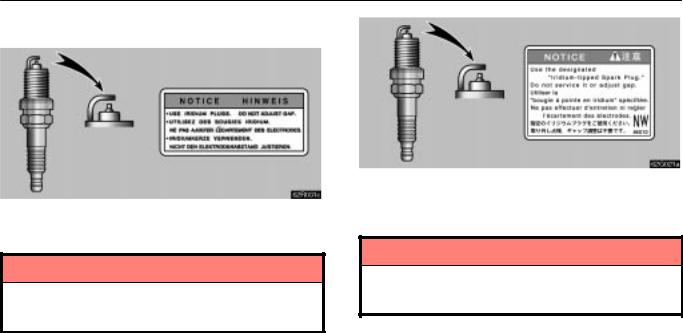
ENGINE
SPARK PLUGS
GS430
Your engine is fitted with iridium±tipped spark plugs.
NOTICE
Use only iridium±tipped spark plugs and do not adjust gaps for your engine performance and smooth drivability.
GS300
Your engine is fitted with the designated iridium±tipped spark plugs.
NOTICE
Use the designated iridium±tipped spark plugs and do not adjust gaps for your engine performance and smooth drivability.
257
ENGINE
258

SECTION 7
REPORTING SAFETY DEFECTS FOR U.S. OWNERS
Reporting safety defects for U.S. owners . . . . . . . . . . . . . . . . . . . . 308
307

REPORTING SAFETY DEFECTS
REPORTING SAFETY DEFECTS
FOR U.S. OWNERS
If you believe that your vehicle has a defect which could cause a crash or could cause injury or death, you should immediately inform the National Highway Traffic Safety Administration (NHTSA) in addition to notifying Toyota Motor Sales, U.S.A., Inc. (Toll±free: 1±800±25±LEXUS).
If NHTSA receives similar complaints, it may open an investigation, and if it finds that a safety defect exists in a group of vehicles, it may order a recall and remedy campaign. However, NHTSA cannot become involved in individual problems between you, your dealer, or Toyota Motor Sales, U.S.A., Inc.
To contact NHTSA, you may either call the Auto Safety Hotline toll±free at 1±800±424±9393 (or 366±0123 in Washington, D.C. area) or write to: NHTSA, U.S. Department of Transportation, Washington, D.C. 20590. You can also obtain other information about motor vehicle safety from the Hotline.
308

SECTION 6 ± 5
SERVICE PROCEDURES AND
SPECIFICATIONS
Body
Specifications . . . . . . . . . . . . . . . . . . . . . . . . . . . . . . . . . . . . . . . . . . . 300 Protecting your vehicle from corrosion . . . . . . . . . . . . . . . . . . . . . . 301 Washing and waxing . . . . . . . . . . . . . . . . . . . . . . . . . . . . . . . . . . . . . 302 Cleaning the interior . . . . . . . . . . . . . . . . . . . . . . . . . . . . . . . . . . . . . . 304
299

BODY
SPECIFICATIONS
± DIMENSIONS AND WEIGHT
Overall length |
4805 mm (189.2 in.) |
Overall width |
1800 mm (70.9 in.) |
Overall height |
1440 mm (56.7 in.)* |
Wheelbase |
2800 mm (110.2 in.) |
Tread ± Front |
1535 mm (60.4 in.) |
± Rear |
1510 mm (59.4 in.) |
Vehicle capacity weight (occupants + luggage) |
400 kg (880 lb.) |
|
|
*Unladen vehicle |
|
± FUEL TANK |
|
|
|
Capacity |
75 L (19.8 gal., 16.5 lmp.gal.) |
|
|
300

BODY
PROTECTING YOUR VEHICLE
FROM CORROSION
Proper care of your Lexus can help ensure long±term corrosion prevention.
The most common causes of corrosion to your vehicle are:
The accumulation of road salt, dirt and moisture in hard±to±reach areas under the vehicle.
Chipping of paint or undercoating caused by minor accidents or by stones and gravel.
The following conditions will cause or accelerate corrosion of your vehicle, so it is important to keep your vehicle, particularly the underside, as clean as possible and to repair any damage to paint or protective coatings as soon as possible.
The presence of road salt or dust control chemicals, salt in the air near the sea coast, industrial air pollution.
High humidity, especially at temperatures just above freezing point.
Certain parts of your vehicle are wet or damp for an extended period of time, even though other parts of the vehicle are dry.
Components of the vehicle which are prevented from quick±drying due to lack of proper ventilation are exposed to high ambient temperature.
To help prevent corrosion on your Lexus, follow these guidelines:
Keep your vehicle clean by regular washing. In addition, observe the following points.
If you drive on salted roads in the winter or if you live near the ocean, you should hose off the undercarriage at least once a month to minimize corrosion.
High pressure water or steam is effective for cleaning the vehicle's underside and wheel housings. Pay particular attention to these areas as it is difficult to see all the mud and dirt. It will do more harm than good to simply wet the mud and debris without removing them. The lower edge of doors, rocker panels and frame members have drain holes which should not be allowed to clog with dirt as trapped water in these areas can cause corrosion.
Wash the underside of the vehicle thoroughly when winter is over.
See ºWashing and waxingº on page 302 for more tips.
Check the condition of your vehicle's paint and trim. If you find any chips or scratches in the paint, touch them up immediately to prevent corrosion from starting. If the chips or scratches have gone through the bare metal, have a qualified body shop make the repair.
301

BODY
Check the interior of your vehicle. Water and dirt can accumulate under the floor mats and could cause corrosion. Occasionally check under the mats to make sure the area is dry. Be particularly careful when transporting chemicals, cleansers, fertilizers, salt, etc. These should be transported in proper containers. If a spill or leak should occur, immediately clean and dry the area.
Keep your vehicle in a well ventilated garage or a roofed place. Do not park your vehicle in a damp, poorly ventilated garage. If you wash your vehicle in the garage, or if you drive it in covered with water or snow, your garage may be so damp it will cause corrosion. Even if your garage is heated, a wet vehicle can corrode if the ventilation is poor.
WASHING AND WAXING
Washing your Lexus
Keep your vehicle clean by regular washing.
The following cases may cause weakness to the paint or corrosion to the body and parts. Wash your vehicle as soon as possible.
When driving in a coastal area
When driving on a road sprinkled with antifreeze
When having coal tar, tree sap, bird droppings and carcass of an insect
When driving in the areas where there is a lot of smoke, soot, dust, iron dust and chemical substance
When the vehicle becomes remarkably dirty with dust and mud
Hand±washing your Lexus
Work in the shade and wait until the vehicle body is not hot to the touch.
1.Rinse off loose dirt with a hose. Remove any mud or road salt from the underside of the vehicle or in the wheel wells.
2.Wash with a mild car±wash soap, mixed according to the manufacturer's instructions. Use a soft cotton mitt and keep it wet by dipping it frequently into the wash water. Do not rub hard ± let the soap and water remove the dirt.
302

BODY
Plastic wheel ornaments: The plastic wheel ornaments are damaged easily by organic substances. If any organic substance splashes an ornament, be sure to wash it off with water and check if the ornament is damaged.
CAUTION
Do not attach the heavily damaged plastic wheel ornament. It may fly off the wheel and cause accidents while the vehicle is moving.
Aluminum wheels: Use only a mild soap or neutral detergent.
Urethane bumpers and side moldings: Wash carefully. Do not scrub with abrasive cleaners. The bumper and side molding faces are soft.
Road tar: Remove with turpentine or cleaners that are marked safe for painted surfaces.
NOTICE
Do not use organic substances (gasoline, kerosene, benzine or strong solvents), which may be toxic or cause damage.
3.Rinse thoroughly ± dried soap can cause streaking. In hot weather you may need to rinse each section right after you wash it.
4.To prevent water spots, dry the vehicle using a clean soft cotton towel. Do not rub or press hard ± you might scratch the paint.
Automatic car wash
Your vehicle may be washed in an automatic car wash, but remember that the paint can be scratched by some type of brushes, unfiltered washing water, or the washing process itself. Scratching reduces paint durability and gloss, especially on darker colors. The manager of the car wash should be able to advise you whether the process is safe for the paint on your vehicle.
Waxing your Lexus
Polishing and waxing is recommended to maintain the original beauty of your Lexus' finish.
Once a month or if the vehicle surface does not repel water well, apply wax.
1.Always wash and dry the vehicle surface before you begin waxing, even if you are using a combined cleaner and wax.
2.Use a good quality polish and wax. If the finish has become extremely weathered, use a car±cleaning polish, followed by a separate wax. Carefully follow the manufacturer's instructions and precautions. Be sure to polish and wax the chrome trim as well as the paint.
3.Wax the vehicle again when water does not bead but remains on the surface in large patches.
303
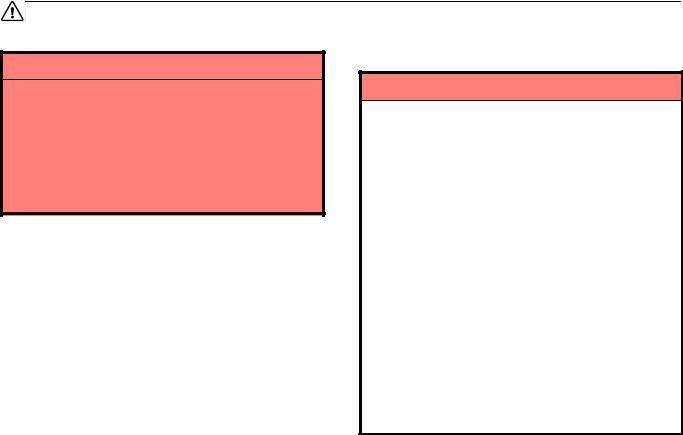
BODY
CLEANING THE INTERIOR
CAUTION
Be careful not to splash water or spill liquid on the floor. This may prevent the side airbags from activating correctly, resulting in serious injury.
Do not wash the vehicle floor with water, or allow water to get onto the floor when cleaning the vehicle interior or exterior. Water may get into audio components or other electrical components above or under the floor carpet (or mat) and cause a malfunction; and it may cause body corrosion.
Leather Interior
The selected leather is used in your Lexus. Due to a leather product, some parts of leather may be rough, uneven or scratched originally.
To keep good appearance, we recommend you to clean it periodically twice a year.
Remove dirt on the leather in the following ways:
1.Wipe it off lightly using a soft cloth (e.g. gauze) dampened with 5% solution of neutral detergent for wool.
2.Wring water from a clean cloth and thoroughly wipe off all traces of detergent with it.
3. Wipe off the surface of the leather with a dry soft cloth. Allow the leather to dry in a ventilated shaded area. Excess of wet may cause the hardening or shrinking of the leather.
NOTICE
Dirt or sand adhered to the leather may damage the treated surface and cause it to wear earlier. Remove dirt or sand using a vacuum cleaner.
If a stain should fail to come out with a neutral detergent, apply a cleaner that does not contain an organic solvent.
Never use organic substances such as benzine, alcohol or gasoline, or alkaline or acid solutions for cleaning the leather as these could cause discoloring.
Use of a nylon brush or synthetic fiber cloth, etc. may scratch the fine grained surface of the leather.
Mildew may develop on soiled leather upholstery. Be especially careful to avoid oil spots. Try to keep your upholstery always clean.
Long exposure to direct sunlight may cause the leather surface to harden and shrink. Keep your vehicle in a shaded area, especially in the summer.
The interior of your vehicle is apt to heat up on hot summer days, so avoid placing on the upholstery items made of vinyl or plastic or containing wax as these tend to stick to leather when warm.
304
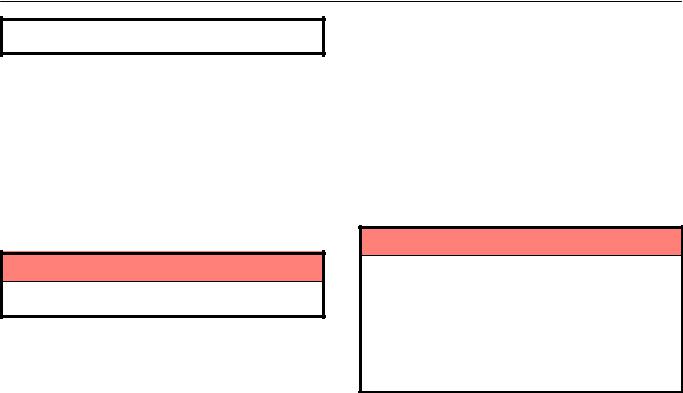
BODY
Improper cleaning of the leather upholstery could result in discoloration or staining.
Synthetic Leather Areas (Dash and sun visors)
The synthetic leather areas may be easily cleaned with a mild soap or detergent and water.
First vacuum over the upholstery to remove loose dirt. Then, using a sponge or soft cloth, apply the soap solution to the synthetic leather. After allowing it to soak in for a few minutes to loosen the dirt, remove the dirt and wipe off the soap with a clean damp cloth. If all the dirt does not come off, repeat the procedure. Commercial foaming±type cleaners are also available which work well. Follow the manufacturer's instructions.
NOTICE
Do not use solvent, thinner, gasoline or window cleaner on the interior.
Carpets, Windows and Seat Belts
Begin by vacuuming thoroughly to remove as much dirt as possible. Several types of foam cleaners are available; some are in aerosol cans and others are powders or liquids which you mix with water to produce a foam. To shampoo the carpets, use a sponge or brush to apply the foam. Rub in overlapping circles. Do not apply water ± the best results are obtained by keeping the carpet as dry as possible. Read the shampoo instructions and follow them closely.
The seat belts may be cleaned with mild soap and water or with lukewarm water.
Use a cloth or sponge. As you are cleaning, check the belts for excessive wear, fraying or cuts.
NOTICE
Use a good foam±type shampoo to clean the carpets.
Do not use dye or bleach on the belts ± it may weaken them.
Do not use the belts until they become dry.
The windows may be cleaned with any household window cleaner.
When cleaning the inside of the rear window, be careful not to scratch or damage the heater wires.
305

BODY
Air Conditioning Control Panel, Car Audio,
Instrument Panel, Console Panel, and
Switches
Use a soft damp cloth for cleaning.
Soak a clean soft cloth in water or lukewarm water then lightly wipe off any dirt.
NOTICE
Do not use organic substances (solvents, kerosene, alcohol, gasoline, etc.) or alkaline or acidic solutions. These chemicals can cause discoloring, staining or peeling of the surface.
If you use cleaners or polishing agents, make sure their ingredients do not include the substances mentioned above.
If you use a liquid car freshener, do not spill the liquid onto the vehicle's interior surfaces. It may contain the ingredients mentioned above. Immediately clean any spill using the method mentioned above.
If you have any questions about the cleaning of your Lexus, your local Lexus dealer will be pleased to answer them.
306

SECTION 6 ± 4
SERVICE PROCEDURES AND
SPECIFICATIONS
Electrical components
Specifications . . . . . . . . . . . . . . . . . . . . . . . . . . . . . . . . . . . . . . . . . . . 280 Checking battery condition . . . . . . . . . . . . . . . . . . . . . . . . . . . . . . . . 284 Battery recharging precautions . . . . . . . . . . . . . . . . . . . . . . . . . . . . 286 Checking and replacing the blade type fuses . . . . . . . . . . . . . . . . 287 Checking the cartridge type fuses . . . . . . . . . . . . . . . . . . . . . . . . . . 289 Adding washer fluid . . . . . . . . . . . . . . . . . . . . . . . . . . . . . . . . . . . . . . 290 Checking the headlight aim . . . . . . . . . . . . . . . . . . . . . . . . . . . . . . . . 291 Replacing light bulbs . . . . . . . . . . . . . . . . . . . . . . . . . . . . . . . . . . . . . 296
279
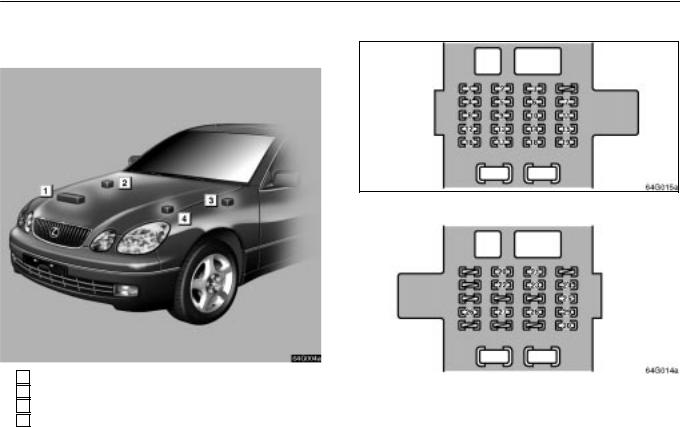
ELECTRICAL COMPONENTS
SPECIFICATIONS
± FUSE LOCATION
± FUSES
Driver's side kick panel
1 Engine compartment |
|
|
|
||
|
|
|
|||
|
|
|
|||
Passenger's side kick panel |
|||||
2 |
Passenger's side kick panel |
||||
|
|
|
|||
3Driver's side kick panel
4Engine compartment
280
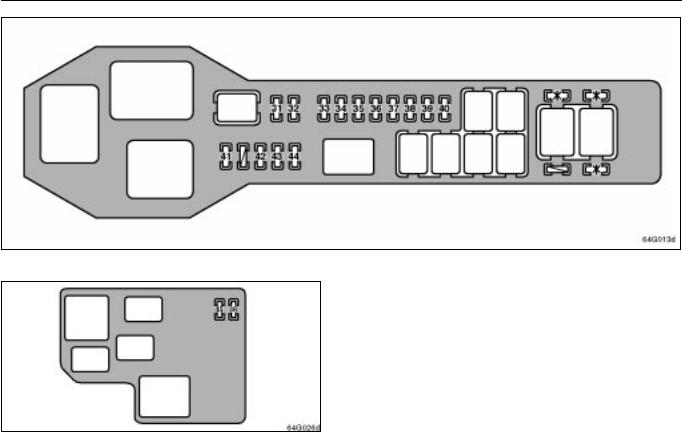
ELECTRICAL COMPONENTS
Engine compartment
Engine compartment
281

ELECTRICAL COMPONENTS
No. |
FUSE |
AMPERE |
CIRCUIT |
|
|
|
|
|
|
1 |
WASHER |
20 |
Windshield washer |
|
|
|
|
|
|
2 |
FR FOG |
15 |
Fog lights |
|
|
|
|
|
|
|
|
|
Tail lights, Side marker lights, |
|
3 |
TAIL |
10 |
License plate lights, |
|
|
|
|
Parking lights |
|
|
|
|
|
|
|
|
|
Back±up lights, Gauges and |
|
4 |
GAUGE |
10 |
meters, service reminder |
|
|
|
|
indicators and buzzers |
|
|
|
|
|
|
5 |
FUEL OPN |
10 |
Fuel filler door opener |
|
|
|
|
|
|
|
D FR |
|
Power window system, |
|
6 |
20 |
Door lock system, |
||
DOOR |
||||
|
|
Wireless remote control |
||
|
|
|
||
|
|
|
|
|
7 |
PANEL |
7.5 |
Emergency flashers, |
|
Headlight cleaner |
||||
|
|
|
||
|
|
|
|
|
8 |
HEATER |
10 |
Air conditioning |
|
|
|
|
|
|
|
|
|
Gauges and meters, service |
|
9 |
SRS±B |
5 |
reminder indicators and |
|
|
|
|
warning buzzers |
|
|
|
|
|
|
10 |
D P/SEAT |
30 |
Power seat system |
|
|
|
|
|
|
11 |
RADIO |
15 |
Audio, Shift lock system |
|
NO.2 |
|
|||
|
|
|
||
|
|
|
|
|
12 |
WIPER |
25 |
Windshield wipers |
|
|
|
|
|
|
13 |
OBD |
7.5 |
On±board diagnosis |
|
|
|
|
|
|
|
|
|
Stop lights, |
|
14 |
STOP |
15 |
Anti±lock brake system, |
|
|
|
|
Traction control system |
|
|
|
|
|
No. |
FUSE |
AMPERE |
CIRCUIT |
|
|
|
|
|
|
15 |
CIG |
15 |
Cigarette lighter, Power outlet |
|
|
|
|
|
|
|
|
|
Power window, Door lock |
|
16 |
ECU±IG |
15 |
system, Wireless remote |
|
|
|
|
control, Theft deterrent system |
|
|
|
|
|
|
17 |
STARTER |
5 |
Starting system |
|
|
|
|
|
|
|
|
|
Multiport fuel injection |
|
|
|
|
system/sequential multiport fuel |
|
18 |
IGN |
5 |
injection system, SRS, |
|
Anti±lock brake system, |
||||
|
|
|
||
|
|
|
Vehicle skid control system, |
|
|
|
|
Cruise control system |
|
|
|
|
|
|
|
D RR |
|
Power window system, |
|
19 |
20 |
Door lock system, |
||
DOOR |
||||
|
|
Wireless remote control |
||
|
|
|
||
|
|
|
|
|
20 |
RR FOG |
10 |
No circuit |
|
|
|
|
|
|
21 |
MIR HTR |
10 |
Outside rear view mirror |
|
|
|
|
|
|
22 |
S/ROOF |
25 |
Moon roof |
|
|
|
|
|
|
|
P FR |
|
Power window system, |
|
23 |
20 |
Door lock system, |
||
DOOR |
||||
|
|
Wireless remote control |
||
|
|
|
||
|
|
|
|
|
24 |
P P/SEAT |
30 |
Power seat system, |
|
Tilt and telescopic steering |
||||
|
|
|
||
|
|
|
|
|
25 |
DOME |
10 |
Interior lights, Personal lights, |
|
Vanity lights, Trunk light, Clock |
||||
|
|
|
||
|
|
|
|
|
26 |
SEAT HTR |
20 |
Seat heater |
|
|
|
|
|
282
